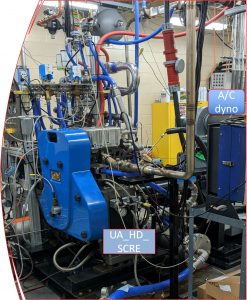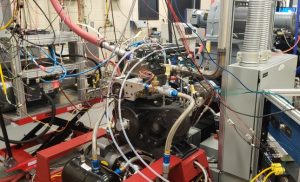Sundar Rajan Krishnan
Professor and Associate Department Head for Graduate Studies
Department of Mechanical Engineering
https://scholar.google.com/citations?user=V0Xf7GwAAAAJ&hl=en
Kalyan Kumar Srinivasan
Professor and Interim Department Head
Department of Mechanical Engineering
https://scholar.google.com/citations?user=tFXA-5wAAAAJ&hl=en
PhD Students:
Yamini Baskara Babu, Muhannad Hendy, Justin Gray, Stephen Mundy, Hariraja Thothadri
Visiting Scholar:
Dr. Giacomo Silvagni (Univ. Bologna)
The single cylinder engines (SCE) lab is self-contained and fully instrumented to study combustion concepts such as partially premixed combustion, dual fuel low temperature combustion, etc., using conventional and alternative fuels. The lab features a heavy-duty single cylinder engine (SCE) and a medium-duty SCE. Engine power is absorbed using a 393 HP AC dynamometer (with motoring capabilities) that is connected to either SCE using custom driveshafts and a Dyne Systems Inter-Loc V dynamometer controller is used to control engine speed. Dedicated air compressors, equipped with inline dryers, supply compressed air to support intake manifold pressures up to 5 bar (abs.) over the entire range of engine speeds.

Turbocharging is simulated for each engine using a combination of intake and exhaust surge tanks, back pressure valves, intake pressure regulators, and control and shutoff valves. Dedicated high pressure fuel injection systems, utilizing Delphi DFP5 and Bosch CP3 injection pumps, are available. Gaseous fuels (e.g., natural gas, propane, etc.) are metered from outside the lab into the test cell and controlled with pressure regulators and automated control valves. All fuel flow rates are measured using high-accuracy Coriolis flow meters while the air flow rates are measured using sonic (choked) nozzles.
The entire operation of each SCE setup is automated and controlled through LabView-based data acquisition and control systems. The high-pressure direct injection (DI) systems for both SCEs and the VVA system on the HD SCE are controlled by National Instruments Direct (Injector) Control and Measurement (DCM) devices while high-speed data from the SCEs are recorded using Vieletech’s Combustion Analysis Toolkit (VCAT) software. Both SCEs also have their own sets of high-speed and low-speed data acquisition systems, sensors and actuators, air, fuel, coolant, lubrication, and exhaust systems, and engine control units. Both engines have been custom-designed and custom-built to suit our research needs while offering the flexibility to perform a variety of advanced combustion experiments with different fuels.
The monitoring stations and control computers are placed outside the test cell, behind large, noise-attenuating observation windows. Emissions measurement instrumentation includes:
- A five-gas Richmond emissions bench to measure engine-out emissions of CO, CO2, and O2 (with non-dispersive infrared and paramagnetic analyzers), total (wet or dry) hydrocarbons (with a heated flame ionization detector), and wet oxides of nitrogen (with a chemiluminescence detector).
- Particulate matter (PM) sizes (from 5.6 nm to 560 nm) and number concentrations are measured using a TSI Engine Exhaust Particle Sizer (EEPS) spectrometer.
- Smoke emissions are measured using an AVL 415S variable sampling smoke-meter.

Heavy-Duty SCE is a single-cylinder version of a six-cylinder PACCAR MX11 truck engine with displacement of 1.8 L, 123 mm bore, 152 mm stroke, compression ratio of 18, and peak chamber pressure of 280 bar. It is equipped with a custom-designed, independently controlled, cam-phaser-based variable valve actuation (VVA) system and a simulated turbocharging setup with temperature-controlled exhaust gas recirculation (EGR) capabilities. The engine is also equipped for allowing endoscopic access into the combustion chamber. Current research focuses on single fuel and dual fuel advanced combustion strategies with applications to on-road and offroad vehicles.
Medium-Duty SCE is a custom-designed medium-duty engine with two available versions: (a) a two-valve proprietary cylinder head, and (b) a four-valve Cummins ISB cylinder head with overhead cams. This engine also has an independent controller and data acquisition system, a simulated turbocharging system with easy adaptability for facilitating EGR capabilities. The medium-duty SCE has been used for conventional diesel combustion studies as well as advanced dual fuel combustion of low-carbon fuels.
Low-Carbon Fuels for advanced combustion is a focus area of research. The lab is equipped to handle various conventional and novel liquid and gaseous fuels, including natural gas, propane, oxymethylene ethers (OMEx), alcohol fuels (methanol, ethanol, butanol, etc.), and diesel. The lab is currently being modified to accommodate hydrogen; another low-carbon fuel that is being considered worldwide.

Research Examples:
Related Publications: